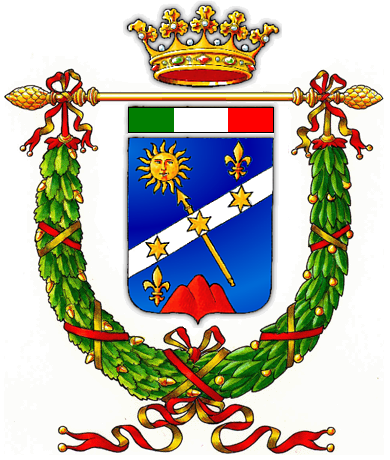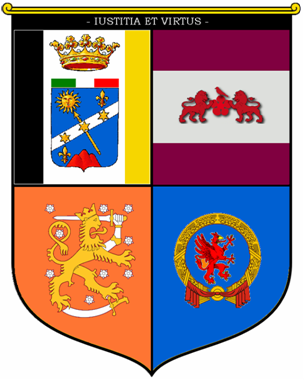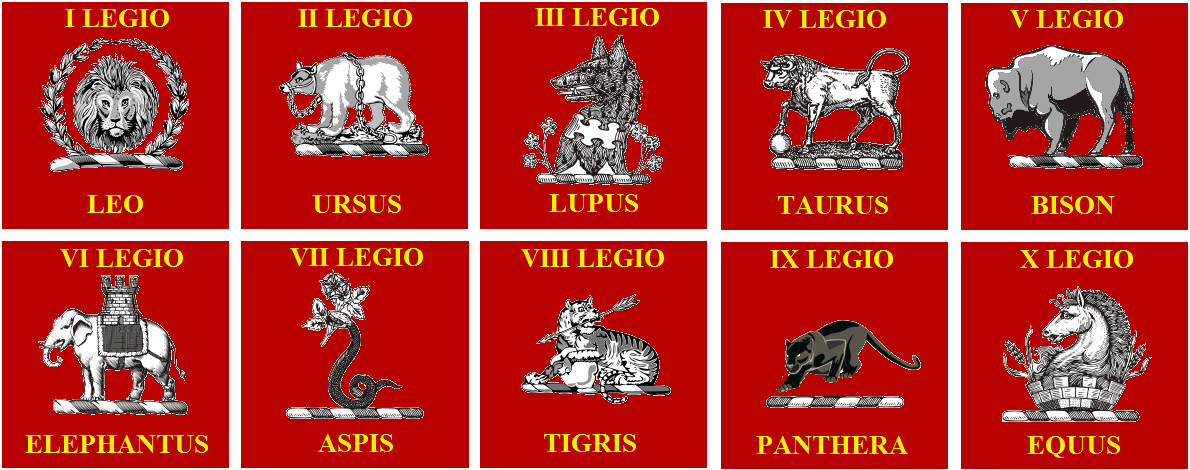Nasuti
| Flag of Nasuti | |
| Motto: Appicce lu compiuter. | |
| File:Nasutimap.jpg MAP | |
| Region | Catholic |
|---|---|
| Capital | Stronghold of Nasuti |
| Official Language(s) | Italian, Lancianese |
| Leader | His Catholic Majesty Prince Cris I |
| Population | 622 milion |
| Currency | Lira del Camerlengo |
| NS Sunset XML | |
Contents
Principato Romano Cattolico di Nasuti
Principato Romano Cattolico di Nasuti (The Roman Catholic Princedom of Nasuti) is a Nation of the region Catholic, member of UN, member of Catholic Council and signer of the Catholic Charter. The capital city is Stronghold of Nasuti, a town built around to a medieval fortress. The Roman Catholic Princedom of Nasuti refer itself whit short form Nasuti.
The official language of the Nasuti is Italian, but a lot citizen speak (not exist a reference text for coding the writing) an ancient language called "Lancianese" native of the ancient domination that the Princedom was submitted.
Nation's adjectival form is Nasutian (Nasutere in Lancianese) and and it is the same for noun for persons from this nation.
The population is of about 600 millions, but the continuous growth carries the analysts to indicate the achievement of 1 billion within the end of the year 2007.
Major ethnic groups is Italic Nasutian (95%), German (2%), English (2%), French (0.5%) and Polish (0.5%).
The Holy Flag of the Principato Romano Cattolico di Nasuti is, from left to right, black, white and yellow, with the coat of arms of the Sovereign Royal Family on the white cloth.
Story of Nasuti and of Sovereign Royal Family
From foundation to Lanciane's Domination
The story and the legend tells that the first village of the Princedom was Samnium, whose origin comes make go back around 1100 BC. Subsequently in Roman period the villages became a colony of the Republic, with the name of Castra Samnium. Castra Samnium became Municipium in 132 b.C. with the name of Anxianum and it had this status until the barbaric invasions. Whit the statal reform of Augustus Samnium Region became the name of the region under the controll of Anxianum.
With the arrival of the first Christian evangelist, the populations of the region converted themselves immediately to the Christianity, recognizing the True God and the True Faith. The Christian community had immediately lively exchanges with the Bishops of Rome and did not embrace any heretical theory of paleo-Christian period.
During fall of the Western Roman Empire, the Samnium Region was sacked by the Goths, and Anxianum was partially destroyed during the Lombard invasion (c. 570 AD). In 610, however, the region was conquered by the Byzantines, who found the Duchy of Samnium and allowed the trades to restart. In the late 8th century the Duchy was conquered by the Franks, who fight against the Muslim pirates with the precious help of the people of the region.
In 9th century the Duchy divided themselves and Anxianum returned independent with the name of Anxano Sannita. In the medieval age in all of the region came built some outposts fortified, particularly the most large it was the Fortress of the Samnium in the Anxano Sannita and a new settlement was then created around the castle.
In 1060 the Normans made the region a centre of trade and Anxano Sannita receiving important privileges by both Frederick II and his son Manfred, with a substantial administrative autonomy. With a new period of development and of flowering of the commerce, the region expanded themselves until to occupy almost all of the current area, with the annexation in the sphere of influence of the territories of Rizzacorno, Riegne, and Feltrin, left after the barbaric invasions and now returned to shine thanks to the commerce. The power was managed from noble faithful to the Holy Roman Empire but during the conflict between Pope and the Empire, although the noble are lined up with the Emperor, the people rhymed faithful to the Pope. In 1112, after hunted it of the "unfaithful noble", many territory of the region (Castle Frentan, Teate, Solomona, Villa Ripa) decided to unite with Anxano Sannita in a commercial and politic union called League of Samnium that give a reasonable independence. Many free citizens of the League enlisted voluntarily to participate at the Crusades for the liberation of the Holy Land and, besides in middle east, they should confront the Muslim also on the native ground, threatened by the continuous raids.
The independence, the privileges and the commercial riches developed still of more in the Renaissance collapsed with the civil war against the Duchy of Lanciane, that invaded all the member of the League in 1572 and subjected it until the 18th century. The new dominator governed with iron fist and despotism, until the crash with some of the religious authority of the region. However under the domination fermented the seeds of the revolution and more times local rebellions had been suffocated in the blood. In 17th century also the Duchy was devastated from the plague and economical crisis became more strong contributing to the growth of the popular discontent. Track of the dark period of the domination is remained only in the language speak by a lot citizen, without hatred for the inhabitants of Lanciane. In fact, with the increase of rebellions, the Duchy began to fall in a more internal deep crisis and to the moment of the definitive crash, fortunately, the people of dissolved dominator and their brothers of the new Kingdom have chosen the way of the reconciliation in Christ.
The Rebellion an the Kingdom
In 1715 began the general rebellion that carried first to the rebellion of all of the people against the Duchy and then to the independence of the community. The rebellion was driven from some limb of the people and from some old noble noble of the pre-domination: with a series of committees they drive the rebels to the victory with the minimum crashes and convincing also the original citizens of the Duchy. After the victory, for the temporary government, was created an assembly of heroic rebels and wise, the Council of Sages and Braves. After little years the Council decided to create an united kingdom where could adhere all the local regions. The sovereignty had entrusted to the family of the most courageous one of the commanders of rebellion, Lord Ferdinando Domenico Nasuti Baron of Stronghold of Anxano (new name of Anxano Sannita).
The first one King was Nicola I the Great, grandchild of Ferdinando Domenico, crowned King of Samnium in 1780. Nicola I, admirer of the struggle for the independence of the USA and of their constitutional democracy, basins the first democratic Constitution that established the power of the King and the power of the Council of Sages and Braves. He fixed the capital in the town of Stronghold of Anxano and he consolidated the absolute relations of faithfulness to the Pope and to the Roman Catholic Church with an agreement and oath both valid for all of the its sovereigns successors.
During the kingdom of Ferdinando I the Charitable and Gildo I the Just, the trouble of death was progressively abolished and was founded the Gathering for the Law of the Laymen for the management of the justice. Besides also in the kingdom appeared the industrial revolution, that in little years fixed the economy of the region and carried the economical development to a level ever reached first without the exploitation of the proletariat thanks to the farsighted application of the social doctrine of the Church forced by the Sovereigns and the religious authority.
In 1890 King Gildo III the Reformer decided to substitute the Council of Sages and Braves with the Senate of the Faithful and reform the state establishing the present type of government (with the division of the power betweeen the King, the Senate of the Faithful and the Gathering for the Law of the Laymen); the last session of the Council of Sages and Braves decided to change the name of the Kingdom with the name of sovereign family: the Kingdom of Samnium became the Constitutional Monarchy of Nasuti. The Kingdom did not participate to the World Wars I.
In 1930, for the 150th anniversary of the coronation of Nicola I the Great and of the kingdom of the Nasuti, King Domenico I and the Senate of the Faithful approved the change of the name of the capital in Stronghold of Nasuti.
King Domenico II the Peaceful guaranteed the neutrality of the kingdom during World Wars II and the neighboring indipendent regions of Gaeta and Costs of Teate asked of to be annas to the kingdom.
King Raffaele I and his son Nicola II inaugurated the season of the "short and modern kingdom": both after little years of kingdom have abdicated in favor of the sons. In 1980, after little months from its coronation, the King Nicola II celebrated the 200th anniversary from the coronation of its homonymous predecessor Nicola I. In 200 years it was ensured to the Kingdom the peace and the calm, the development and the well-being. Some intellectual of the Nation advanced the idea of a "Pax Nasuti", but the King denied his support to this conviction remembering that the "only peace is in Christ and not in the men".
After the abdication of King Nicola II, the King Cris I announced a referendum that changed the Constitutional Monarchy to Princedom, taking again in part the ancient title of "Roman Catholic". The Pricnipe Cris I has wanted the presence of its two enlightened predecessors to its flank in the government of the Princedom.
Chronology of the sovereign family
| King | born | crowned | dead |
|---|---|---|---|
| Ferdinando Domenico Nasuti (not King, one of the commanders of the rebellion), | 1682 | 1745 | |
| Domenico Nasuti (not King, Member of Council of Sages and Braves) | 1712 | 1761 | |
| Nicola I the Great, 1st King | 1735 | 1780 | 1790 |
| Ferdinando I the Charitable | 1760 | 1790 | 1833 |
| Gildo I the Just | 1792 | 1833 | 1856 |
| Gildo II the Elder | 1818 | 1856, abdicated in 1887 | 1898 |
| Gildo III the Reformer | 1847 | 1887 | 1921 |
| Domenico I | 1873 | 1921 | 1925 |
| Domenico II the Peaceful | 1902 | 1925 | 1964 |
| Raffaele I | 1924 | 1965, abdicated in 1979 | |
| Nicola II | 1955 | 1979, abdicated in 2004 | |
| Cris I | 1980 | 2004, became 1st Prince in 2007 |
Government
Executive
Nasuti is a Constitutional Princedom with separation of powers: legislative to the Senate of the Faithful; executive to the hereditary Prince (with title of "His Catholic Majesty Prince"); justice to the Gathering for the Law of the Laymen.
Head of State and of Government is His Catholic Majesty Prince Cris I and his vice is Bishop or Cardinal of the Frentan diocese named from the Pope. A part of the executive is chosen personally from the Prince, while remaining is named according to the result of the votes.
Ministers and Advisors:
- Minister of the Insides and of the Defence: Distinguished Prince Nicola II, chosen by the Prince;
- Advisors of the Prince for the Foreign Relationship: Duke Aldo and Dukess Patricia of Gaeta, chosen by the Prince; the Prince treats personally the diplomatic relationship with the foreign countries;
- Minister of the Treasury: Countess Sara of Castle Frentan, elected;
- Minister for the Free Information: Countess Azzurra of Feltrin, elected;
- Minister for the Science, Technology, Reserch and Development: Countess Faby of Riegne;
- Chief of the Integrated Catholic Educational System: Bishop or Cardinal of the Frentan diocese;
Legislative
The Senate of the Faithful is composed from 50 elected Senators and maximum 10 Senators to life named from the Prince. Can become Senators all of the pratice catholic citizens than have more of 30 years and that lend public profession of faith.
The Senate proposes, discusses and approves the ordinary laws. The constitution can be changed only with the authorization of the Prince.
Justice
The Gathering for the Law of the Laymen is the civil for the justice. Is chief is the Distinguished Prince Raffaele I, chosen by the Prince.
Coats of arms of the Establishment
Nasuti administrative division
[[image:Nasutiregion.jpg|thumb|400px][REGION MAP]
The Princedom is divided in 12 Regions, with a limited local autonomy, derived from the ancient territories of the Samnium Region:
1. Samnium Region, with the capital town Stronghold of Nasuti
2. Castle Frentan
3. Teate
4. Solomona
5. Villa Ripa
6. County of Feltrin
7. County of Riegne
8. Earldom of Rizzacorno
9. Valley of Carmelo
10. Duchy of Lanciane
11. Duchy of Gaeta
12. Costs of Teate
Religion
The religion is a fundamental appearance of the life of the state and of the citizens. The Official State Religion is Roman Catholic (professed by 99% of citizens): Nasuti is a nation of Christians loyal to the traditions of the Roman Catholic Church and obedient to Supreme Pontiff Pope Benedict XVI. The Nasutian are faithful to the moral and to the teachings of Jesus Christ and of His Church.
Other Religions is professed by 1% and to them is guaranteed the freedom of religion and the independence from Catholic Church authority with special law.
Military
Supreme Commandant chief of the Military Forces is William Adama, chosen from Prince Nicola II when it governed and maintained in service from Prince Cristian I for military merits. the Supreme Commandant has a partial autonomy but obeys directly to the Prince.
An esteem (the number is not precise for the secret composition of some special departments) attributes to the Armed Forces 1'500'000 regular fighting enlisted and trained, 0.2% of population.
Every citizen after 20th birthday is submitted annually to a period of 20 days of training that give back it in the "Reserve Corps for the Defence of the Homeland”. The most expert voluntarily are framed in the reservist Legions.
The Constitution and the moral of Nasuti expects the use of the Military Forces only for defend the Nation and its allies, but refuses the use of the force like tool of aggression and submission.
Military Forces composition
The Military Forces of the Princedom is composed by:
- 10 Army Legions, I-X Legio: Leo, Ursus, Lupus, Taurus, Bison, Elephantus, Aspis, Tigris, Panthera, Equus.
- 10 Marine Legions, XI-XX Legio: Selachi, Fulguru, Manta, Sphyraenida, Delphinus, Octopus, Nautilus, Medusa, Caronte, Nemo.
- 10 Aviation and Aerospace Legions, XXI - XXX Legio: Aquila, Accipiter, Milvus, Bubo, Draco, Vultur, Corvus, Merula, Enterprise, Von Braun.
Each Legio is divided into 10 Cohortes.
Each Cohort consisting of 100 Centuries.
Each Century consisting 50 - 200 soldiers.
Legions Insigna
Military Ranks
Ranks under the Supreme Commandant chief of the Military Forces
| Army Ranks | Marine Ranks | Aviation and Aerospace Ranks |
|---|---|---|
| General, lead 1 Legion | Admiral, lead 1 Legion | Air Marshal, lead 1 Legion |
| Brigadier | Commodore | Chief Master |
| Colonnel | Captain | Captain Master |
| Army Commander | Marine Commander | Air Commander |
| Major, lead 1 Cohort | Lieutenant Commander, lead 1 Cohort | Air Leader, lead 1 Cohort |
| Captain | Lieutenant | Master Sergeant |
| Lieutenant | Sub-Lieutenant | Sergeant |
| Army Centurio, lead 1 Centuries | Marine Centurio, lead 1 Centuries | Air Centurio, lead 1 Centuries |
| Milites, individual soldiers | Marine, individual soldiers | Air Legionarii, individual soldiers |
| LEGION OFFICIALS | COHORT OFFICIALS | CENTURIES OFFICIALS | SOLDIER | ||||||
|---|---|---|---|---|---|---|---|---|---|
| Insignia | 
|

|

|

|

|

|

|

|
NO INSIGNIA |
| Title | General | Brigadier | Colonnel | A. Commander | Major | Captain | Lieutenant | A. Centurio | Milites |
Civil Life
School
In Nasuti the education entrusted by the Integrated Catholic Educational System:
- obligatory Jesuit school from 5 to 18 year; - Catholic University;
For not Catholic there is voluntary abstention from some disciplines, to replace with other choices from the Gathering for the Law of the Laymen.

















